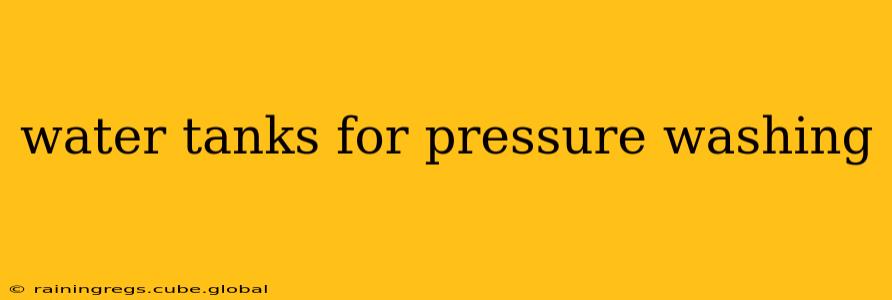Pressure washing is a powerful cleaning method, but its effectiveness hinges on consistent water pressure and ample supply. A reliable water tank can be the difference between a quick, efficient cleaning job and a frustrating, sputtering mess. This guide explores the various types of water tanks ideal for pressure washing, addressing key considerations for choosing the right one for your needs.
What are the Different Types of Water Tanks Used for Pressure Washing?
Several tank types cater to different pressure washing applications and budgets. The most common include:
-
Above-Ground Storage Tanks: These are widely available and relatively inexpensive. They're suitable for smaller jobs or supplementing a municipal water supply. Common materials include plastic (polyethylene) and steel. Plastic is lightweight and less prone to rust, while steel offers greater durability. The size varies greatly, so choose one that aligns with your project’s water volume requirements.
-
Underground Storage Tanks: These are a more permanent solution, often used for larger-scale pressure washing operations or where space above ground is limited. They are typically made from durable materials like steel or fiberglass-reinforced plastic, designed to withstand underground conditions. However, installation is more complex and expensive.
-
Water Bladders: These flexible tanks are lightweight and portable, making them perfect for mobile pressure washing operations or reaching areas inaccessible to larger tanks. They are generally less expensive than rigid tanks but have a lower pressure capacity.
-
Integrated Water Tanks (on Pressure Washers): Some pressure washers have integrated tanks, convenient for smaller tasks. However, these typically have limited capacity, making them unsuitable for extensive cleaning jobs.
What Size Water Tank Do I Need for Pressure Washing?
The ideal tank size depends on the size and frequency of your pressure washing projects. Consider these factors:
- The size of the area to be cleaned: Larger areas naturally require more water.
- The type of surface being cleaned: Porous surfaces like wood or brick absorb more water than non-porous surfaces like concrete.
- The pressure washer's flow rate: A higher flow rate will deplete the tank faster.
- The frequency of use: Frequent use necessitates a larger capacity to minimize refills.
A good rule of thumb is to overestimate your water needs rather than underestimate. Running out of water mid-job is significantly more disruptive than having excess water on hand.
How Much Does a Water Tank for Pressure Washing Cost?
Costs vary dramatically based on tank size, material, and type. Smaller, above-ground plastic tanks can cost a few hundred dollars, while larger, underground steel tanks can run into thousands. Water bladders offer a budget-friendly option, while integrated tanks are usually included in the price of the pressure washer itself.
Can I Use a Regular Water Tank for Pressure Washing?
While you can use a regular water tank, it's crucial to ensure it's compatible with the pressure washer's requirements. Some tanks might not be able to withstand the pressure, leading to leaks or damage. Additionally, consider the tank's material; some materials are more resistant to chemicals used in pressure washing solutions. Always check the tank's pressure rating before use.
What are the Best Water Tanks for Pressure Washing?
There's no single "best" water tank; the optimal choice depends on your specific needs and budget. Research different brands and models, considering factors like capacity, durability, material, and portability. Reading customer reviews can provide valuable insights into the real-world performance of different tanks.
How Do I Maintain a Water Tank Used for Pressure Washing?
Regular maintenance extends the lifespan of your water tank. This includes:
- Regular cleaning: Remove sediment and debris to prevent clogs and ensure efficient water flow.
- Inspection for leaks: Regularly check for any signs of leaks or damage.
- Proper winterization: If you live in a cold climate, take steps to prevent freezing and damage during winter.
By choosing the right water tank and implementing proper maintenance, you can significantly enhance the efficiency and effectiveness of your pressure washing operations. Remember to prioritize safety and always adhere to the manufacturer’s instructions.
